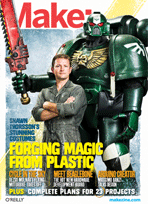
Have you been wanting to get into embedded Linux platform BeagleBone but not sure where to start? Our own Matt Richardson has a great Skill Builder piece in MAKE Volume 32 to help you get going. You can access it on Make: Projects.
From the intro:
Many makers love microcontroller platforms like the Arduino, but as the complexity increases in an electronics project, sometimes a microcontroller just won’t cut it and you need something with a little more “oomph.”
For example, if you want to use a camera and computer vision to detect dirty dishes in your sink, it might be a good idea to explore your options with embedded Linux platforms. These boards are generally more powerful and capable, and are sometimes the perfect solution for projects that are too complex for our beloved microcontrollers.
Not only that, but as the price of embedded Linux platforms drops, the community of support around them grows, which makes them much more accessible to novice and intermediate makers than ever before.
The BeagleBone is an embedded Linux development board that’s aimed at hackers and tinkerers. It’s a smaller, more barebones version of the BeagleBoard. Both are open source hardware and use Texas Instrument’s OMAP processors, which are designed for low-power mobile devices.
Matt shows you how to get set up via Ethernet, control pins from the command line, light an LED, and read a button, giving you a solid foundation. Previous to writing the piece for the magazine, Matt had done a great starter blog post that has a good comment thread you might want to check out.

From the pages of MAKE:
MAKE Volume 32: Design for Makers
Forget duct tape and baling wire — now makers can design and manufacture things as beautiful as Apple and as slick as Dyson. We’ll show you how to conceive and visualize great-looking projects with our speed course in industrial design.
2 thoughts on “New to BeagleBone?”
Comments are closed.
ADVERTISEMENT
Join Make: Community Today











ohh my good !